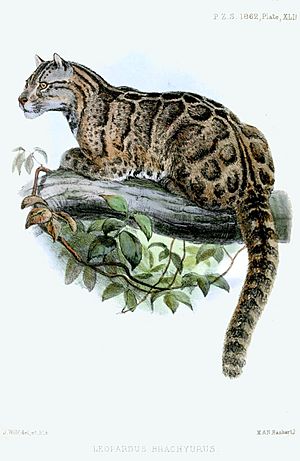Neofelis facts for kids
Quick facts for kids Neofelis |
|
|---|---|
 |
|
| Clouded leopard (Neofelis nebulosa) | |
| Scientific classification | |
| Kingdom: | |
| Phylum: | |
| Class: | |
| Order: | |
| Family: | |
| Subfamily: | |
| Genus: |
Neofelis
Gray, 1867
|
| Species | |
Neofelis is a group of two amazing cat species found in Southeast Asia. These are the clouded leopard (Neofelis nebulosa) and the Sunda clouded leopard (Neofelis diardi). The clouded leopard lives on mainland Asia, while the Sunda clouded leopard is found on the islands of Sumatra and Borneo.
The scientific name Neofelis comes from two words. Neo- is Greek for "new," and feles is Latin for "cat." So, Neofelis literally means "new cat."
Contents
What Makes Neofelis Special?

Neofelis cats have some unique features. Their skull is long, and their face is wide and flat, like their forehead. They have large nose bones and medium-sized eye sockets.
One of their most striking features is their very long, cone-shaped canine teeth. These teeth are sharp on the back edge. Their skulls are a bit like those of the ancient Smilodon, which also had very long upper canine teeth.
Compared to a regular leopard, Neofelis skulls have wider nose bones at the back. Their lower jaw is also raised quite a bit at the front. The Sunda clouded leopard has even longer upper canine teeth and a narrower roof of the mouth between them.
Where Do Clouded Leopards Live?
Neofelis species live across a wide area in Asia. You can find them from Nepal and Sikkim in the west, all the way to southern China and Hainan. They also live southeast in places like Burma, Annam, the Malay Peninsula, Sumatra, and Borneo.
These cats mostly live in evergreen tropical rainforests. However, they can also be found in forests that have grown back after being cut down, or even in grassland and bushy areas. In the Himalayan foothills, they have been seen at heights up to 1,450 meters (about 4,757 feet).
What Threats Do They Face?
The biggest danger for both Neofelis species is Deforestation. This means their forest homes are being cut down. They are also threatened by poaching, which is illegal hunting. Poachers catch them for the wildlife trade.
Their skins, claws, and teeth are sold for decorations or clothing. Their bones and meat are sometimes used in traditional Asian medicines, often as a replacement for tiger parts. Sadly, some are also caught alive to be sold as pets. While not many poaching incidents are officially recorded, it is believed to happen in all the countries where they live. Recently, there have been big markets for these animals in Indonesia, Myanmar, and Vietnam.
How Are They Protected?
Both Neofelis species are listed in CITES Appendix I. This means they are highly protected around the world. Hunting them is against the law in most of the places they live.
Countries where hunting is banned include Bangladesh, Brunei, Cambodia, China, India, Indonesia, Malaysia, Myanmar, Nepal, Taiwan, Thailand, and Vietnam. In Laos, there are strict rules about hunting them.
See also
 In Spanish: Leopardos nebulosos para niños
In Spanish: Leopardos nebulosos para niños

